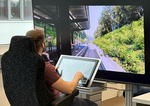Studentenarbeiten
Definition und Implementation von Key Performance Indicators (KPI) und Analysewerkzeugen in einer Simulati-onsumgebung Reality (MR)

Stadler verfügt über einen Fahrsimulator, der im Rahmen der Simulation zahlreiche Leistungsdaten ausgibt. Diese werden allerdings nicht ausgewertet. In einem ersten Schritt soll erfasst werden, welche dieser Leistungsdaten für die Ausbildung ausgewertet werden sollen (= KPI). Anschliessend sollen diese in einfach ver-ständlicher Form dargestellt werden. Der Simulator ist im Rahmen der Arbeit für den Studierenden zu den üblichen Geschäftszeiten bei der Stadler Rheintal AG zugänglich. Ausserhalb dieser Zeiten steht ein Laborplatz am ICVR zur Verfügung.
Schlagwörter
Mixed Reality; KPI; Simulator
Labels
Master Thesis
PLEASE LOG IN TO SEE DESCRIPTION
This project is set to limited visibility by its publisher. To see the project description you need to log in at SiROP. Please follow these instructions:
- Click link "Open this project..." below.
- Log in to SiROP using your university login or create an account to see the details.
If your affiliation is not created automatically, please follow these instructions: http://bit.ly/sirop-affiliate
Mehr Informationen
Dieses Projekt öffnen... call_made
Publiziert seit: 2025-02-09 , Frühester Start: 2025-03-01 , Spätestes Ende: 2025-09-30
Bewerbungen eingeschränkt auf ETH Zurich
Organisation(en) Innovation Center Virtual Reality
Host(s) Kunz Andreas, Prof.
Themen Information, Computing and Communication Sciences
Prozedurale Generierung virtueller Welten

Mithilfe der Unreal Engine 5 sollen realitätsnahe digitale Umgebungen von einigen Quadratkilometern Grösse parametrisiert generiert werden. Das System soll verschiedene Landschaftsarten unterstützen (sowohl Topografie, Besiedlungsgrad, Vegetation, Klimazone) und sich an definierte Gleistrassen anpassen. Ebenso muss sich die generierte mit fest definierter Landschaft verbinden lassen. Im Rahmen der Arbeit muss mindestens ein Landschaftstyp ausgearbeitet werden. Zur Erstellung der prozeduralen Inhalte sollen nach Möglichkeit Systeme verwendet werden, die bereits in der Unreal Engine 5 integriert sind.
Schlagwörter
Virtual Reality
Labels
Master Thesis
PLEASE LOG IN TO SEE DESCRIPTION
This project is set to limited visibility by its publisher. To see the project description you need to log in at SiROP. Please follow these instructions:
- Click link "Open this project..." below.
- Log in to SiROP using your university login or create an account to see the details.
If your affiliation is not created automatically, please follow these instructions: http://bit.ly/sirop-affiliate
Mehr Informationen
Dieses Projekt öffnen... call_made
Publiziert seit: 2025-02-09 , Frühester Start: 2025-03-01 , Spätestes Ende: 2025-09-30
Bewerbungen eingeschränkt auf ETH Zurich
Organisation(en) Innovation Center Virtual Reality
Host(s) Kunz Andreas, Prof.
Themen Information, Computing and Communication Sciences
Daisy Chaining Tracking Follow-up

Recent development allows for navigating a virtual environment by real walking, thanks to the SLAM technology, which localizes a user’s position and builds a map on the fly. For doing so, this technology relies on visible static features in the tracking space, while other users are filtered out and not considered for positional tracking. Hence, the system presumes that each user can track his position individually. However, far very large tracking spaces these visible features might be too far away. To overcome this problem, a daisy-chaining of tracking information of users was developed, were only one observed user needs an absolute reference.
Schlagwörter
Virtual Reality, Tracking, Multi-user environment, Computer Vision
Labels
Semester Project , Bachelor Thesis , Master Thesis
Description
In the previous project, we developed a framework to track multiple users, each wearing a VR headset. We utilized the YOLO algorithm to identify an observed user in images captured from the perspective of another user's VR headset. Once identified, we calculated the relative position of this observed user. This step was crucial for maintaining the accuracy of both users' virtual positions and for reestablishing tracking if it was lost for any of the users. This framework ensured continuous, accurate tracking within a multi-user VR environment. This work will build on that foundation. Initially, you will need to familiarize yourself with the already implemented framework. Subsequently, your task will be to enhance the tracking accuracy and speed by refining individual components and testing new algorithms. You will also need to develop a new method to determine the orientation of an observed user. Following this, you will conduct tests to evaluate the accuracy of the system.
Contact Details
Mathieu Lutfallah, mlutfallah@ethz.ch
Mehr Informationen
Dieses Projekt öffnen... call_made
Publiziert seit: 2024-12-12 , Frühester Start: 2024-12-31 , Spätestes Ende: 2025-06-01
Bewerbungen eingeschränkt auf ETH Zurich
Organisation(en) Innovation Center Virtual Reality
Host(s) Lutfallah Mathieu
Themen Information, Computing and Communication Sciences